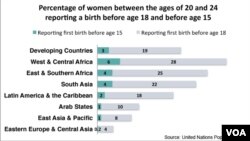GENEVA —
A new report by the United Nations Population Fund (UNFPA) finds millions of adolescent girls suffer serious long-term health and social consequences from pregnancy. Globally, the U.N. agency estimates 7.3 million girls under 18-years-old give birth, including two million girls younger than 14.
Giving birth to a baby should be a happy moment in the life of a woman. But, for millions of adolescents around the world, early pregnancy and childbirth results in serious health problems, social exclusion and even death.
In developing countries, 20,000 girls under 18 give birth every day, the report says. It estimates some 70,000 adolescents in developing countries die each year from complications during pregnancy and childbirth. Among those who survive, many will develop an obstetric fistula. This is a hole in the birth canal, which leaves the girl leaking urine constantly.
The director of the UNFPA office in Geneva, Alanna Armitage, says adolescent girls are at increased risk of child marriage and sexual coercion. Maternal death among girls under the age of 15 from low- and middle-income countries is twice that of older females," says Armitage.
“Our report shows that nine out of 10 pregnancies to girls under 18 take place within a marriage. And, as you may know, every day, 39,000 girls are married in violation of their basic human rights. One in nine is married before the age of 15 and this, of course, will continue as long as families, communities and governments tolerate child marriage," she said.
The report highlights the economic impact of adolescent pregnancy. It notes the lifetime opportunity costs related to adolescent pregnancy range from one percent of annual GDP in China to 30 percent of annual GDP in Uganda.
To drive this point home, the report notes $3.4 billion could have been added to the Kenyan economy had the more than 200,000 adolescent mothers in the country been employed rather than pregnant.
The report finds in every region of the world, impoverished, poorly educated rural girls are more likely to become pregnant than those who live in richer, more urban areas. UNFPA Senior Maternal Health Advisor Luc de Bernis says the highest rates of adolescent maternal mortality are found in Sub-Saharan Africa and South Asia.
He says the problem is marginally greater in the Francophone than the English-speaking African countries.
“Africa is not homogeneous and we have many differences, but the fact is young girls are not protected in the majority of these countries -- not in the Francophone for sure...and not in the English speaking world," said Bernis. "In Kenya, Uganda, you have a rate of abortion which is absolutely enormous and it explains a big part of the maternal mortality. A big number of these abortions occur among very young girls.”
The report says adolescent pregnancy is a much bigger challenge in the developing world than in developed countries. But it finds that adolescent pregnancy is still a significant issue in the richer nations.
It says blaming a young girl for getting pregnant is counter-productive. Instead of changing the girl’s behavior, the report says, society should change its attitudes and actions.
Among the recommendations for reducing adolescent pregnancy with its related risks, the report suggests keeping girls in school, stopping child marriage, and providing adolescents with access to sexual and reproductive health, including contraception.
Giving birth to a baby should be a happy moment in the life of a woman. But, for millions of adolescents around the world, early pregnancy and childbirth results in serious health problems, social exclusion and even death.
In developing countries, 20,000 girls under 18 give birth every day, the report says. It estimates some 70,000 adolescents in developing countries die each year from complications during pregnancy and childbirth. Among those who survive, many will develop an obstetric fistula. This is a hole in the birth canal, which leaves the girl leaking urine constantly.
The director of the UNFPA office in Geneva, Alanna Armitage, says adolescent girls are at increased risk of child marriage and sexual coercion. Maternal death among girls under the age of 15 from low- and middle-income countries is twice that of older females," says Armitage.
“Our report shows that nine out of 10 pregnancies to girls under 18 take place within a marriage. And, as you may know, every day, 39,000 girls are married in violation of their basic human rights. One in nine is married before the age of 15 and this, of course, will continue as long as families, communities and governments tolerate child marriage," she said.
The report highlights the economic impact of adolescent pregnancy. It notes the lifetime opportunity costs related to adolescent pregnancy range from one percent of annual GDP in China to 30 percent of annual GDP in Uganda.
To drive this point home, the report notes $3.4 billion could have been added to the Kenyan economy had the more than 200,000 adolescent mothers in the country been employed rather than pregnant.
The report finds in every region of the world, impoverished, poorly educated rural girls are more likely to become pregnant than those who live in richer, more urban areas. UNFPA Senior Maternal Health Advisor Luc de Bernis says the highest rates of adolescent maternal mortality are found in Sub-Saharan Africa and South Asia.
He says the problem is marginally greater in the Francophone than the English-speaking African countries.
“Africa is not homogeneous and we have many differences, but the fact is young girls are not protected in the majority of these countries -- not in the Francophone for sure...and not in the English speaking world," said Bernis. "In Kenya, Uganda, you have a rate of abortion which is absolutely enormous and it explains a big part of the maternal mortality. A big number of these abortions occur among very young girls.”
The report says adolescent pregnancy is a much bigger challenge in the developing world than in developed countries. But it finds that adolescent pregnancy is still a significant issue in the richer nations.
It says blaming a young girl for getting pregnant is counter-productive. Instead of changing the girl’s behavior, the report says, society should change its attitudes and actions.
Among the recommendations for reducing adolescent pregnancy with its related risks, the report suggests keeping girls in school, stopping child marriage, and providing adolescents with access to sexual and reproductive health, including contraception.






